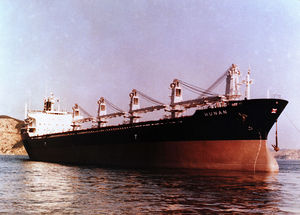Hunan IV
Contents
History
September 1981. Delivered to CNCo.
1990. Sold to the Great Eastern Shipping Co., Bombay. Renamed "Jag Rashni"
2001. Renamed "Radiant Rigel". Tonnage listed as 23,652 grt.
2003. Renamed "Pioneer K".
2003. Renamed "Albatross".
2011. Renamed "Lisboa".
April 23rd. 2012. Broken up.
Service
Events / Stories
She was a well designed, well built, ship. The only funny thing about her was the push button on the bridge console which was labelled "PRESS FOR TYPHOON".
On one occasion, under John Milward, she was discharging wheat off Chittagong, the wheat being transhipped into a ricketty old triple decker with no shifting boards, and the thieving of the Bangladeshi stevedores was more than usually annoying. The Tuvaluan crew turned themselves baseball bats in the workshop and the Master was greeted on his rounds next morning with the sight of a line of thieves, lashed to the rail, and the words "Shall we kill them now, Sir?"
Her easiest charter was to Torm Lines, of Copenhagen, because Torm owned an identical sister ship, so we were never asked silly questions or expected to do the impossible.
She was of her time in that she had chain pull hatch covers and bleeding wing tanks (this is not an obscene expression - the saddle ballast tanks had small tank hatch covers that could be removed so that when carrying light grain the tanks could be filled with grain and, by unbolting a similar hatch on the underside, the grain in the tanks could e "bled" into the holds - these fittings caused a deal of trouble on other ships and within a few years "no bleeding wing tanks" was a term of many charter parties!
Mitsui built her in 420,000 man hours which is double what it would take today but half what British Shipbuilders needed to build the HUPEH (qv) three years later...

